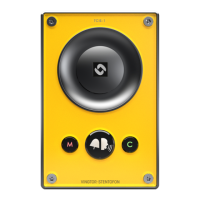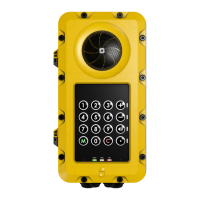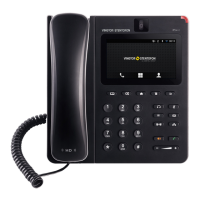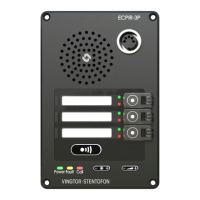Do you have a question about the Vingtor Stentofon TCIS Series and is the answer not in the manual?
Overview and models of Turbine Compact IP Intercoms, including TCIS, TCIV, TKIS, and TMIS series.
Overview of Turbine Extended IP Intercoms, covering Industrial and Ex models like TFIE and TFIX.
Details on connectors for Turbine Compact IP Intercom stations, including Ethernet, power, and I/O.
Details on connectors for Turbine Extended IP Intercom stations, covering industrial models.
Details on connectors for Turbine Ex IP Intercom stations.
Instructions for connecting accessories like handsets and microphones to industrial intercoms via terminal blocks.
Steps to access the web interface and log into the station using default credentials.
Configuring station mode, IP parameters, and selecting product model and accessory.
Configuring volume levels, microphone sensitivity, and audio profiles for better sound quality.
Configuring input/output pins for various functions and LED blink patterns.
Managing station contacts and display text via the address book for scrolling stations.
Customizing display text and font settings for OLED screens on compatible stations.
Setting minimum amplitude and duration for audio detection events.
Configuring time settings via NTP or manual entry for accurate timestamps.
Accessing the web interface to log into the Edge Controller station.
Configuring the Edge Controller mode and IP parameters for system setup.
Adding other intercom stations to the IC-EDGE network for auto-discovery.
Setting up station numbers, names, and IP addresses in the Edge Controller directory.
Setting up and managing group calls, including priority, chime, and members.
Adding and configuring the mobile app for intercom functionality via the Edge Controller.
Adding and configuring external SIP devices like phones to the IC-EDGE system.
Configuring DAKs, inputs, and ring list functions for station call routing.
Accessing the web interface to log into a SIP station for configuration.
Configuring SIP mode, IP parameters, and selecting product model and accessory.
Configuring SIP registration, domains, authentication, and call parameters.
Adjusting speaker volume, volume override, AGC, AVC, and ANC settings.
Configuring relay activation based on station events or DTMF signals.
Configuring time settings via NTP or manual entry for accurate timestamps.
Uploading and configuring prerecorded audio messages for various events.
Accessing advanced settings for I/O, Scripts, and other features.
Configuring SNMP for network device management, traps, and informs.
Setting up IEEE 802.1X for port-based network access control and authentication.
Enabling or disabling network services like SSH, HTTP, SIP, and VoIP through the firewall.
Requirements for upgrading station software, including TFTP server and image files.
Procedure for upgrading station software using the web interface and TFTP protocol.
Description of status LEDs on the front plate of compact and industrial stations.
Explanation of status LEDs located on the Printed Circuit Board (PCB).
Interpreting green and yellow LEDs for Ethernet connection status and speed.
Procedure to reset the station to factory defaults using Activated DHCP.
Procedure to reset the station to factory defaults using a Static IP address.
Pinout and description of connectors on the front of the compact PCB.
Details on the 10-pin terminal for input connectors on the compact board.
Details on output connectors and relay connections for the compact board.
Pinout and description of connectors on the rear of the compact PCB.
Details on connectors for front board components on the compact station.
Pinout and description of connectors on the front of the extended PCB.
Details on the 10-pin terminal for input connectors on the extended board.
| Brand | Vingtor Stentofon |
|---|---|
| Model | TCIS Series |
| Category | Intercom System |
| Language | English |



